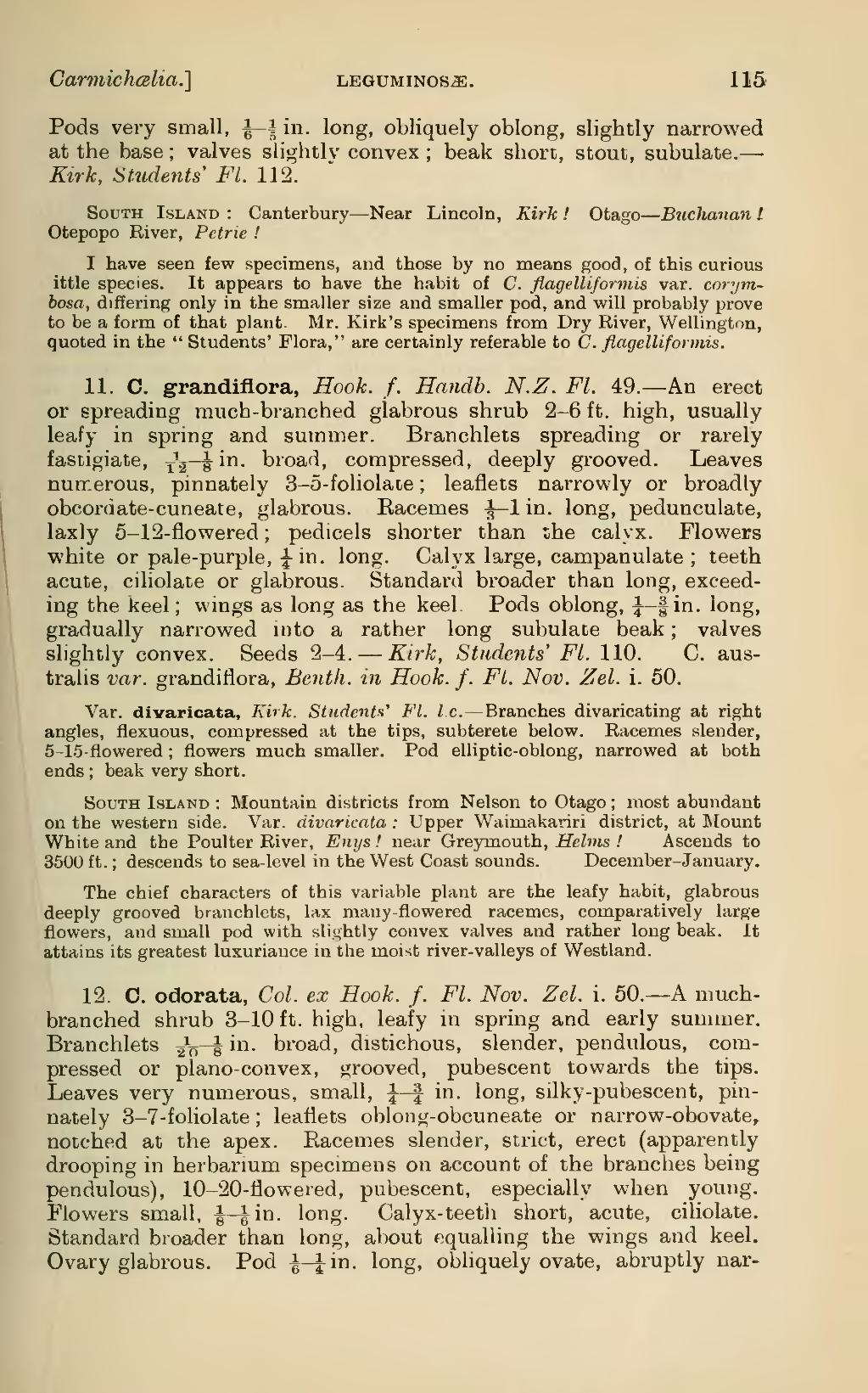Pods very small, 16–15 in. long, obliquely oblong, slightly narrowed at the base; valves slightly convex; beak short, stout, subulate.—Kirk, Students' Fl. 112.
South Island: Canterbury—Near Lincoln, Kirk! Otago—Buchanan! Otepopo River, Petrie!
I have seen few specimens, and those by no means good, of this curious little species. It appears to have the habit of C. flagelliformis var. corymbosa, differing only in the smaller size and smaller pod, and will probably prove to be a form of that plant. Mr. Kirk's specimens from Dry River, Wellington, quoted in the "Students' Flora," are certainly referable to C. flagelliformis.
11. C. grandiflora, Hook. f. Handb. N.Z. Fl. 49.—An erect or spreading much-branched glabrous shrub 2–6 ft. high, usually leafy in spring and summer. Branchlets spreading or rarely fastigiate, 112–18 in. broad, compressed, deeply grooved. Leaves numerous, pinnately 3–5-foliolate; leaflets narrowly or broadly obcordate-cuneate, glabrous. Racemes ⅓–1 in. long, pedunculate, laxly 5–12-flowered; pedicels shorter than the calyx. Flowers white or pale-purple, ¼ in. long. Calyx large, campanulate; teeth acute, ciliolate or glabrous. Standard broader than long, exceeding the keel; wings as long as the keel. Pods oblong, 14–38 in. long, gradually narrowed into a rather long subulate beak; valves slightly convex. Seeds 2–4.—Kirk, Students' Fl. 110. C. australis var. grandiflora, Benth. in Hook. f. Fl. Nov. Zel. i. 50.
Var. divaricata, Kirk. Students' Fl. l.c.—Branches divaricating at right angles, flexuous, compressed at the tips, subterete below. Racemes slender, 5–15 flowered; flowers much smaller. Pod elliptic-oblong, narrowed at both ends; beak very short.
South Island: Mountain districts from Nelson to Otago; most abundant on the western side. Var. divaricata: Upper Waimakariri district, at Mount White and the Poulter River, Enys! near Greymouth, Helms! Ascends to 3500 ft.; descends to sea-level in the West Coast sounds. December–January.
The chief characters of this variable plant are the leafy habit, glabrous deeply grooved branchlets, lax many-flowered racemes, comparatively large flowers, and small pod with slightly convex valves and rather long beak. It attains its greatest luxuriance in the moist river-valleys of Westland.
12. C. odorata, Col. ex Hook. f. Fl. Nov. Zel. i. 50.—A much-branched shrub 3–10 ft. high, leafy in spring and early summer. Branchlets 120–18 in. broad, distichous, slender, pendulous, compressed or plano-convex, grooved, pubescent towards the tips. Leaves very numerous, small, ¼–¾ in. long, silky-pubescent, pinnately 3–7-foliolate; leaflets oblong-obcuneate or narrow-obovate, notched at the apex. Racemes slender, strict, erect (apparently drooping in herbarium specimens on account of the branches being pendulous), 10–20-flowered, pubescent, especially when young. Flowers small, 18–16 in. long. Calyx-teeth short, acute, ciliolate. Standard broader than long, about equalling the wings and keel. Ovary glabrous. Pod 16–14 in. long, obliquely ovate, abruptly nar-
